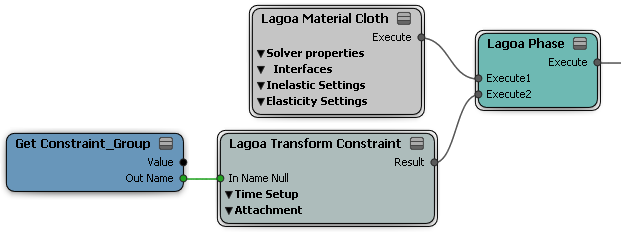You can use the Lagoa Transform Constraint to lock points in Lagoa effects to the positions of nulls. This is useful for pinning cloth, for example, like a flag on a flag pole.

Cloth deformation pinned to two nulls using Lagoa Transform Constraint
If you have a simple Lagoa effect that uses a single phase and material on a point cloud, you can pin regions using menu commands. For other cases, for example if you are using multiple phases, you can pin manually.
Note that to be constrained, points must have their Constrainable attribute activated. This is set in the corresponding Lagoa Emit or Lagoa Init compound.
Pinning to One or More Nulls Using Menu Commands
If desired, you can add one or more nulls to the selection now.
Choose Particles  After Emission
After Emission  Transform Constraint from the ICE toolbar.
Transform Constraint from the ICE toolbar.
If no nulls were selected in step 2, pick one or more nulls to act as pins:
A group containing the nulls is created automatically, called Lagoa_Transform_Constraints, and a Lagoa Transform Constraint compound is connected to the Phase node.
Add a Lagoa Transform Constraint and connect it to a new Execute port of the phase that you want to pin.
Use a Get Data node to get the null that you want to use as a pin, and connect its Out Name to the In Name Null port of the Lagoa Transform Constraint compound.
If you want to use multiple nulls for the same phase, group them in the scene and connect the group instead. See Grouping Objects [Scene Elements].

Modifying Transform Constraints
After you have applied a Transform Constraint, you can modify its effect by:
Adjusting the settings in the Lagoa Transform Constraint compound.